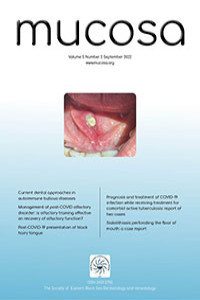Oral liken planus ve oral likenoid reaksiyonlar: Dental seri yama testi sonuçlarının retrospektif olarak değerlendirilmesi
Amaç Oral liken planus (OLP) ve oral likenoid reaksiyonlar (OLR) dental işlemlere ikincil ortaya çıkabilir. Dental seri yama testi, ilgili alerjenin belirlenmesine rehberlik edebilecek basit bir tanı yöntemidir. Bu çalışmada OLP ve OLR hastalarında dental seri yama testi sonuçlarının değerlendirilmesi amaçlanmıştır. Yöntem Klinik ve/veya histopatolojik olarak OLP veya OLR tanısı almış ve Ocak 2015 ile Ocak 2021 arasında dermatoloji kliniğimizde dental seri yama testi yapılan hastaların tıbbi kayıtlarının retrospektif bir incelemesi yapıldı. Bulgular Toplamda, OLP (n=14, %38.9) veya OLR (n=22, %61.1) tanısı alan 36 hasta dahil edildi, bunların 15’inde (% 41.7) yama testi pozitifti. Başvuru anındaki ortalama yaş 54.6 yıldı (28-72 yaş aralığı). Hastalık süresi ortalama 21.9 aydı (1-144 ay aralığı). Yama testlerindeki pozitif bulgular, OLR hastalarında OLP hastalarına göre yaklaşık üç kat daha yüksekti. En sık pozitif reaksiyon (n = 6) altın (I) sodyum tiyosülfat dihidrata karşı tespit edildi. Alışkanlıklar (sigara, alkol) ve komorbiditeler, yama testi sonuçlarıyla önemli ölçüde ilişkili değildi. Sonuç Yama testi ile temas alerjilerinin tespitinin, diş restorasyonları gibi ilişkili değişikliklere yönelik kararlara rehberlik edebileceğini düşünüyoruz.
Anahtar Kelimeler:
dental seri, oral liken planus, oral likenoid reaksiyon, yama testi
Oral lichen planus and oral lichenoid reactions: a retrospective evaluation of patch test results with dental series
Objective Oral lichen planus (OLP) and oral lichenoid reactions (OLR) may occur secondary to dental procedures. Patch testing with the dental series is a simple diagnostic method that can guide the identification of the relevant allergen. In this study, it was aimed to evaluate the patch test results with dental series in OLP and OLR patients. Methods A retrospective review of the medical records of patients who were clinically and/or histopathologically diagnosed with OLP or OLR and, who underwent dental series patch testing at our dermatology clinic in between January 2015 and January 2021 was performed. Results In total, 36 patients with a diagnosis of OLP (n=14, 38.9%) or OLR (n=22, 61.1% ) were included, 15 of whom (41.7%) had positive patch test results. The mean age at presentation was 54.6 years (range 28-72 years). The duration of the disease was 21.9 (range 1-144 months) months on average. Positive findings on patch tests were approximately three times higher in OLR patients than in OLP patients. Gold(I) sodium thiosulfate dihydrate was the most frequent positive reaction (n=6) detected against. Habits (smoking, alcohol) and comorbidities were not significantly associated with the patch test results. Conclusion Detection of allergens with patch test is a helpful diagnostic method for effective control of the disease in both OLP and OLL patients. We think that the detection of contact allergies with patch testing may guide decisions regarding related changes such as dental restorations.
Keywords:
dental series, oral lichen planus, oral lichenoid reactions, patch test,
___
- McCartan BE, Healy CM. The reported prevalence of oral lichen planus: a review and critique. J Oral Pathol Med 2008;37:447-53.
- Al-Hashimi I, Schifter M, Lockhart P, et al. Oral lichen planus and oral lichenoid lesions: diagnostic and therapeutic considerations. Oral Surg Oral Med Oral Pathol Oral Radiol Endod 2007;103:1-12.
- Lodi G, Scully C, Carrozzo M, et al. Current controversies in oral lichen planus: report of an international consensus meeting. Part 2. Clinical management and malignant transformation. Oral Surg Oral Med Oral Pathol Oral Radiol Endod 2005;100:164-78.
- Scully C, Beyli M, Ferreiro M, et al. Update on oral lichen planus; etiopathogenesis and management. Crit Rev Oral Biol Med 1998;9:86-122.
- Eisen D. The clinical features, malignant potential, and systemic associations of oral lichen planus: a study of 723 patients. J Am Acad Dermatol 2002;46:207-14.
- Roopashree MR, Gondhalekar RV, Shashikanth MC, George J, Thippeswamy SH, Shukla A. Pathogenesis of oral lichen planus a review. J Oral Pathol Med 2010;39:729-34.
- Ismail SB, Kumar SKS, Zain RB. Oral lichen planus and Lichenoid reactions; etiopathogenesis, diagnosis, management and malignant transformation. J Oral Sci 2007;49:89-106.
- Eisen D. The clinical manifestations and treatment of oral lichen planus. Dermatol Clin 2003;21:79-89.
- Dudhia BB, Dudhia SB, Patel BS, et al. Oral lichen planus to oral lichenoid lesions: evolution or revolution. J Oral Maxillofac. Pathol 2015;19:364-70.
- Thornhill MH, Pemberton MW, Simmons RK, Theaker ED. Amalgam contact hypersensitivity lesions and oral lichen planus. Oral Surg Oral Med Oral Path 2003;95:291-9.
- Laine J, Kalimo K, Happonen RP. Contact allergy to dental restorative materials in patients with oral lichenoid lesions. Contact Dermatitis 1997;36:141-6.
- Sahin EB, Cetinozman F, Avcu N, Karaduman A. Evaluation of patients with oral lichenoid lesions by dental patch testing and results of removal of the dental restoration material. Turkderm 2016;50:150-6.
- Raap U, Stiesch M, Reh H, et al. Investigation of contact allergy to dental metals in 206 patients. Contact Dermatitis 2009; 60:339-43.
- Tiwari SM, Gebauer K, Frydrych AM, Burrows S. Dental patch testing in patients with undifferentiated oral lichen planus. Australas J Dermatol 2018;59:188-93.
- Koch P, Bahmer FA. Oral lesions and symptoms related to metals used in dental restorations: a clinical, allergological, and histologic study. J Am Acad Dermatol 1999;41:422-30.
- Magnusson B, Blohm SG, Fregert S, et al. Routine patch testing. IV. Supplementary series of test substances for Scandinavian countries. Acta Derm Venereol 1968;48:110-4.
- ISSN: 2651-2750
- Yayın Aralığı: Yılda 3 Sayı
- Başlangıç: 2018
- Yayıncı: Doğu Karadeniz Deri ve Zührevi Hastalıklar Derneği
Sayıdaki Diğer Makaleler
Burcu AYDEMİR, Leyla BAYKAL SELÇUK, Deniz AKSU ARICA, Ali Osman METİNTAŞ
Spontan düzelen konjenital oral lenfoepitelyal kist: Olgu sunumu
Züleyha ÖZGEN, Elif COMERT OZER, Dilek SEÇKİN
Betül DEMİR, Demet ÇİÇEK, İlker ERDEN, Süleyman AYDIN, Özlem ÜÇER, Tuncay KULOĞLU, Mehmet KALAYCI, Meltem YARDIM, Esma YÜKSEL
